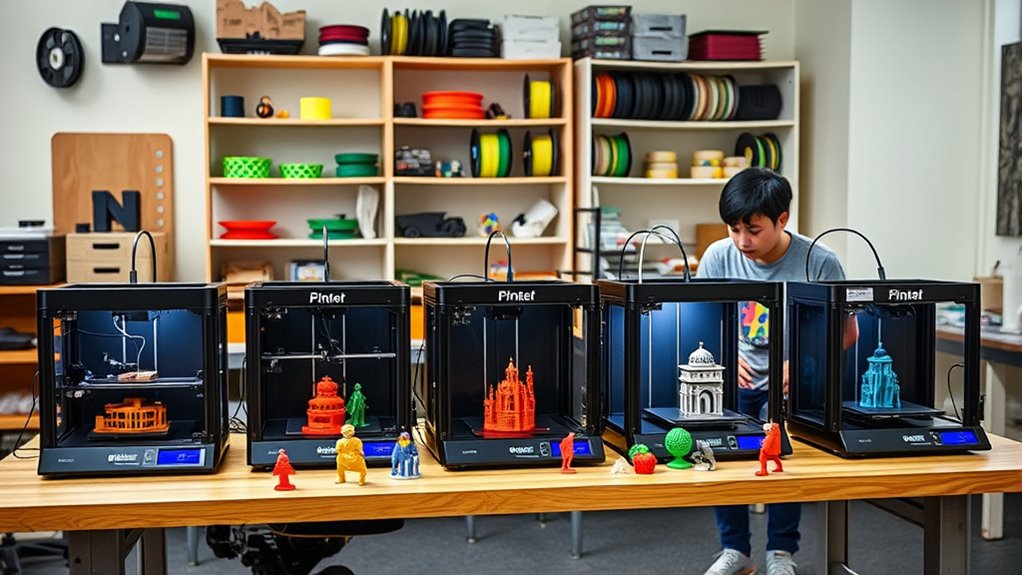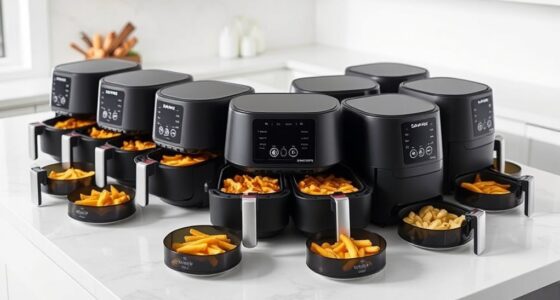If you’re looking for the best 3D printers for students and hobbyists in 2025, I recommend exploring options like the FlashForge Adventurer 5M, ELEGOO Centauri Carbon, and Creality Ender 3. These models combine ease of use, affordability, and versatile features perfect for beginners and creative projects. Whether you want fast printing, multi-color options, or large build volumes, there’s a great choice for you. Keep going to discover more top picks and how to select the right one.
Key Takeaways
- The list features user-friendly, affordable, and versatile 3D printers ideal for students and hobbyists in 2025.
- Top picks include models with auto-leveling, high-speed capabilities, and compatibility with various filaments.
- Printers with large build volumes and easy setup are highlighted for creative flexibility and beginner ease.
- Advanced features like multi-color printing and AI integration cater to creative enthusiasts and educational use.
- The selection balances performance, ease of use, and innovative technology for various skill levels and project needs.
FLASHFORGE Adventurer 5M 3D Printer
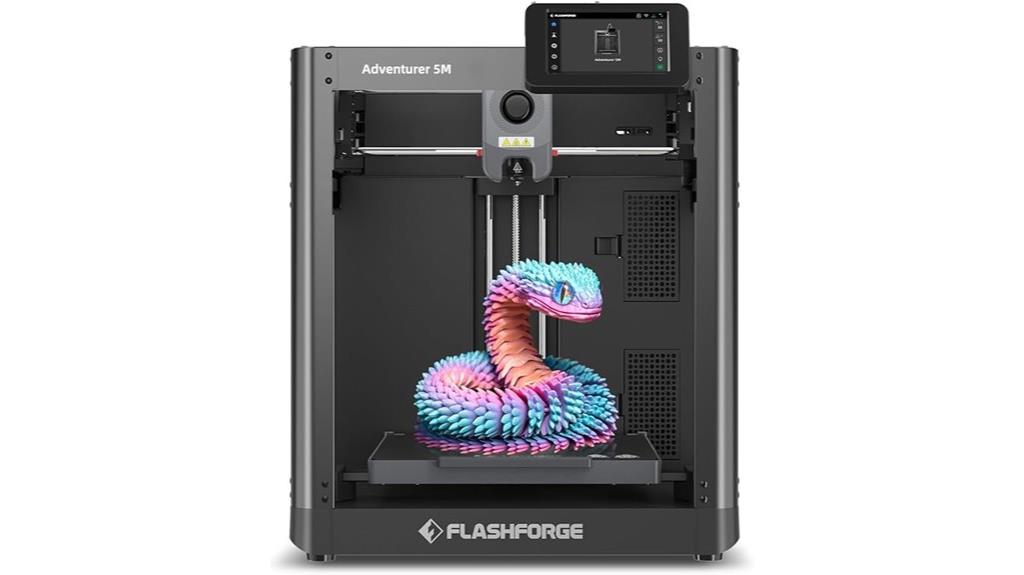
The FlashForge Adventurer 5M stands out as the top choice for students and hobbyists who want high-speed, reliable 3D printing without sacrificing ease of use. I love how its automatic bed leveling makes setup almost effortless, ensuring perfect first layers every time. With speeds reaching 600mm/s, I can complete projects quickly, and the rapid warm-up saves me valuable time. Its sturdy coreXY structure and versatile nozzle options support a wide range of creative ideas. Plus, real-time remote monitoring lets me oversee prints from anywhere, making it perfect for both quick prototypes and detailed models. It’s a powerful, user-friendly machine that truly elevates my 3D printing experience.
Best For: hobbyists, students, and small-scale professionals seeking high-speed, reliable 3D printing with ease of use and versatile features.
Pros:
- Automatic bed leveling ensures perfect first layers and reduces setup time
- High-speed printing up to 600mm/s accelerates project completion
- Real-time remote monitoring via mobile app enhances convenience and control
Cons:
- Relatively lightweight build may impact stability during high-speed printing
- Limited maximum nozzle size (up to 0.8mm) may restrict some large or specialized projects
- As a relatively new model, it may have fewer user-generated troubleshooting resources compared to more established printers
ELEGOO Centauri Carbon 3D Printer with Auto Calibration

If you’re looking for a 3D printer that combines ease of use with professional-level performance, the ELEGOO Centauri Carbon stands out as an ideal choice for students and hobbyists alike. It arrives fully assembled and pre-calibrated, so you can start printing right away. With auto bed leveling, an intuitive touchscreen, and a sizable 10”x10”x10” build volume, it’s perfect for both beginners and seasoned makers. It offers high-speed printing up to 500 mm/s, thanks to its advanced CoreXY structure, and handles advanced filaments like carbon fiber with a heated chamber and high-flow hotend. Plus, smart monitoring features make certain of consistent, high-quality results every time.
Best For: hobbyists, students, and experienced makers seeking a user-friendly, high-speed 3D printer capable of printing detailed, durable parts with advanced materials.
Pros:
- Fully assembled and pre-calibrated for immediate use, reducing setup time
- High-speed printing up to 500 mm/s with precise CoreXY mechanics
- Enclosed chamber with smart monitoring features ensures consistent, high-quality results
Cons:
- Limited build volume compared to larger industrial printers (10”x10”x10”) may restrict very large projects
- Higher price point due to advanced features and materials compatibility
- Enclosed chamber may require careful handling when changing filaments or maintenance
Official Creality Ender 3 3D Printer

For students and hobbyists seeking an affordable yet reliable 3D printer, the Creality Ender 3 stands out thanks to its open-source design and extensive upgrade options. It offers a build volume of 8.66×8.66×9.84 inches, weighing around 15 pounds, and requires about two hours for assembly. The Ender 3 supports printing via SD card or computer, with features like a fast-heating hot bed and upgraded extruder to prevent clogs. Known for its reliability and community support, it’s ideal for those willing to tinker and improve. Overall, it’s a top choice for beginner-friendly, customizable 3D printing without breaking the bank.
Best For: hobbyists, students, and beginners seeking an affordable, customizable 3D printer with a strong community support network.
Pros:
- Open-source design allows for extensive modifications and upgrades
- Reliable performance with fast-heating hot bed and upgraded extruder
- Affordable price point under $200, making it accessible for newcomers
Cons:
- Requires assembly and frequent re-leveling for optimal results
- Limited to printing via SD card or computer, not directly through a phone
- Some users may experience minor issues with bed adhesion and calibration
ELEGOO Neptune 3 Pro 3D Printer

Designed with ease of use and quiet operation in mind, the ELEGOO Neptune 3 Pro stands out as an excellent choice for students and hobbyists alike. Its compact 225x225x280mm build volume suits a variety of projects, while the pre-assembled components and included tools make setup straightforward. The dual-gear direct extruder ensures smooth filament feeding and compatibility with PLA, TPU, PETG, and ABS. Auto bed leveling with high-precision sensors guarantees accurate prints, and the dual Z-axis motors provide stability. Plus, the removable touchscreen offers intuitive control, making 3D printing accessible without sacrificing quality or quiet operation.
Best For: hobbyists, students, and beginners seeking a quiet, user-friendly 3D printer with reliable performance and versatile filament compatibility.
Pros:
- Quiet operation with noise levels around 47-48dB, ideal for shared spaces and classrooms
- Auto bed leveling with high-precision sensors for accurate and consistent prints
- Easy setup with pre-assembled components and intuitive touchscreen controls
Cons:
- Limited build volume of 225x225x280mm, which may restrict large project size
- Dual Z-axis motors and auto-leveling increase initial setup complexity for beginners
- Compatibility primarily with standard filaments, which might limit specialty material use
FLASHFORGE AD5X 3D Printer with Auto Leveling and High-Speed Printing
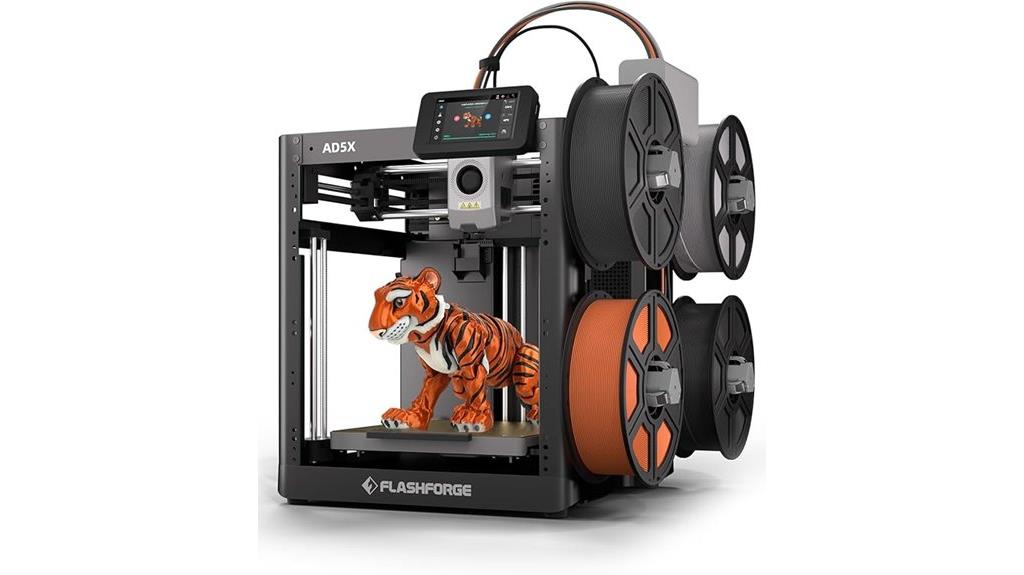
The FLASHFORGE AD5X stands out for its impressive multi-color printing capabilities, supporting up to four colors simultaneously, which opens up creative possibilities for students and hobbyists alike. Its exceptional print quality is achieved through advanced dual-channel cooling, vibration compensation, and a 300°C direct-drive extruder, allowing for detailed and vibrant prints. The printer’s interchangeable nozzles (0.25mm to 0.8mm) offer versatility, from fine details to rapid large prints. With a CoreXY structure enabling speeds up to 600mm/s and automatic bed leveling, it combines speed, precision, and ease of use—perfect for fast, high-quality projects.
Best For: hobbyists, students, and professionals seeking high-speed, multi-color 3D printing with precise detail and user-friendly automation.
Pros:
- Supports up to four colors simultaneously for vibrant, multi-color prints.
- Fast printing speeds up to 600mm/s with stable CoreXY structure.
- Easy to operate with features like 1-Click Auto Leveling and remote control via mobile app.
Cons:
- Larger build volume may require more space and setup time.
- Multiple nozzles and high-speed features may increase maintenance complexity.
- Advanced features might have a learning curve for complete beginners.
Fully Assembled 3D Printer for Kids and Beginners
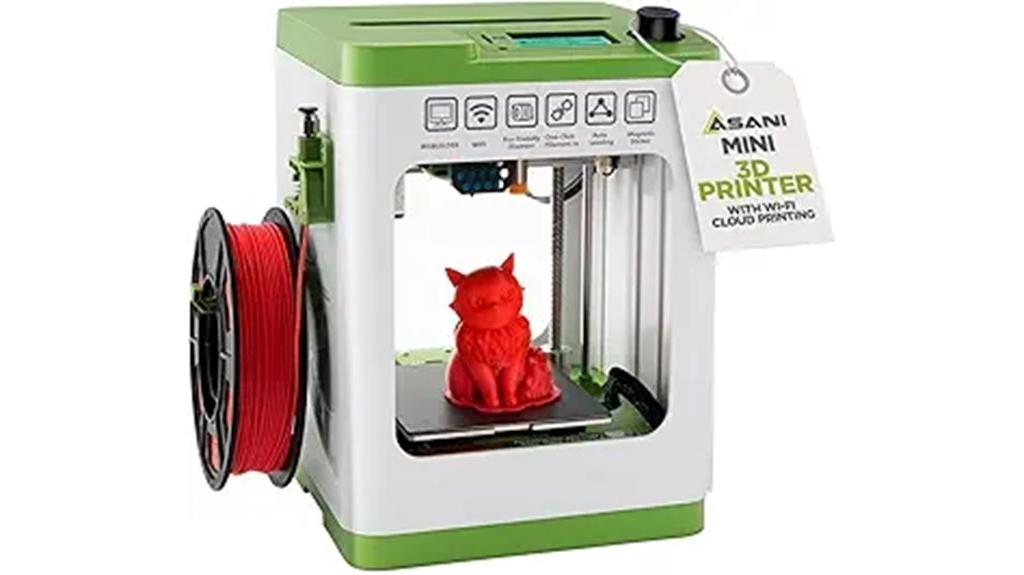
A fully assembled 3D printer simplifies the process for kids and beginners by eliminating complex setup steps, allowing users to start printing right away. It comes as a complete starter kit with everything needed, including a mini printer, 10 meters of PLA filament, a pre-installed microSD card with models and software, and accessories. Its compact size (8.3” x 8.3” x 11.4”) makes it ideal for small spaces like classrooms, homes, or dorms. User-friendly features like auto-leveling, a 2.4” LCD screen, flexible magnetic build plate, and one-touch filament loading guarantee ease of use. Plus, WiFi connectivity and software support make creative printing accessible for all.
Best For: beginners, kids, and educators seeking an easy-to-use, fully assembled 3D printer for educational or home use.
Pros:
- Fully assembled and ready to use right out of the box, saving time and reducing setup errors
- Compact, lightweight design ideal for small spaces like classrooms, homes, or dorms
- User-friendly features such as auto-leveling, LCD control, magnetic build plate, and WiFi connectivity
Cons:
- Limited build volume due to compact size, not suitable for large projects
- Compatibility requires using specific magnetic metal plates for proper sensor function
- May have a learning curve for users unfamiliar with 3D printing software and operations
ELEGOO Mars 5 Resin 3D Printer with 4K Mono LCD
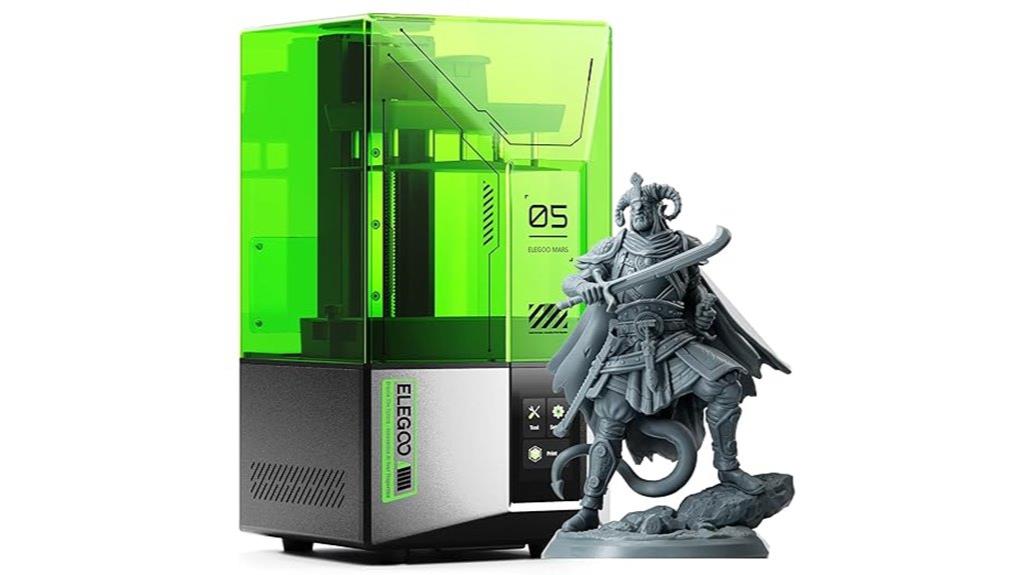
If you’re looking for a resin 3D printer that combines high detail with ease of use, the ELEGOO Mars 5 with its 4K mono LCD is an excellent choice. It features a 4K mono LCD and an advanced COB light source, delivering sharp, detailed textures perfect for miniatures, prototypes, and intricate models. Its automatic leveling and one-click self-check make setup simple, even for beginners. The smart sensors prevent LCD damage, reducing waste and maintenance. With WiFi connectivity, quick print times, and reliable performance, the Mars 5 is ideal for hobbyists and students seeking professional-quality results without hassle. It’s a compact, user-friendly device that elevates resin printing.
Best For: hobbyists, beginners, and professionals seeking high-detail resin printing with ease of use and reliable performance.
Pros:
- High-resolution 4K mono LCD delivers sharp, detailed textures suitable for intricate models.
- Automatic leveling and one-click self-check simplify setup and maintenance, ideal for beginners.
- Smart sensors and enhanced safety features prevent LCD damage and reduce waste during printing.
Cons:
- Limited build volume of 5.65 x 3.53 x 5.91 inches may restrict larger projects.
- Initial setup and resin compatibility might require troubleshooting for new users.
- Dependence on specific resins like Elegoo Water Washable or ABS-Like may limit material options without adjustments.
FLASHFORGE Adventurer 5M 3D Printer
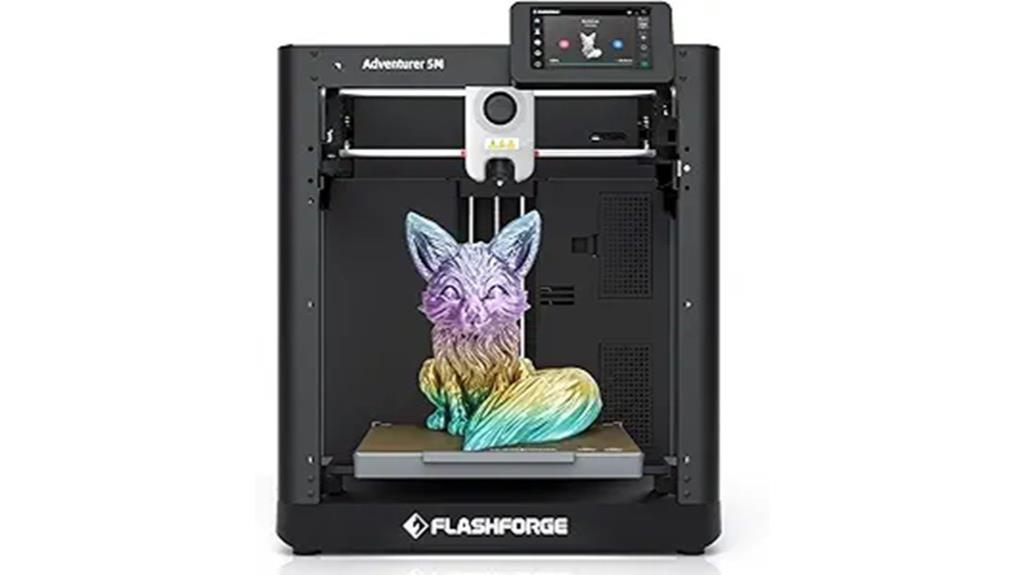
For students and hobbyists aiming to boost productivity and precision, the FlashForge Adventurer 5M stands out with its blazing-fast performance and stable build. Its Core XY all-metal structure reaches speeds up to 600mm/s and accelerates at 20,000mm/s², cutting print times by over 70%. Rapid heating to 200°C in just 35 seconds supports high-temperature filaments, while vibration compensation guarantees smooth, reliable prints. With a high-flow nozzle and support for various materials like PLA, PETG, and ABS, it delivers detailed results. The one-click automatic bed leveling and dual-sided PEI platform simplify setup and removal, making it perfect for quick, high-quality projects.
Best For: students and hobbyists seeking fast, high-precision 3D printing with easy setup and versatile material options.
Pros:
- Exceptional high-speed performance with speeds up to 600mm/s and rapid heating in 35 seconds
- Automatic bed leveling and dual-sided PEI platform for quick, hassle-free setup and model removal
- Supports a wide range of filament types, including high-temperature and composite materials
Cons:
- The high-speed operation may require careful calibration for optimal quality
- Limited to certain filament types; may not be suitable for industrial-grade materials
- App-based remote control requires additional accessories like the camera kit for full functionality
AI-Powered 3D Printer for Kids

The AOSEED AI-Powered X-Maker Joy 3D Printer stands out as the perfect choice for kids and beginners, thanks to its intuitive features that foster creativity without requiring prior experience. It offers AI Doodle to generate models from voice, text, or images, and AI MiniMe to turn photos into cartoon figures, making design fun and accessible. The printer’s one-click setup, voice commands, and safety features guarantee a seamless experience. With high speeds, precise accuracy, and real-time monitoring via a built-in camera, kids can create quickly and confidently. Its extensive library of models and all-in-one kit make it easy to start exploring 3D printing right away.
Best For: Beginners and kids interested in creative 3D printing who want an easy, safe, and fast way to bring their ideas to life.
Pros:
- User-friendly with one-click setup, voice commands, and safety features
- Fast printing speeds up to 400mm/s with high precision (0.05mm)
- Extensive library of over 1,500 models and real-time remote monitoring
Cons:
- May be less suitable for advanced users seeking professional-grade 3D printing options
- The all-in-one kit, while comprehensive, might be costly for some budgets
- Dependence on Wi-Fi connectivity for optimal operation and remote monitoring
TINA2Plus 3D Printer with WiFi Cloud Printing
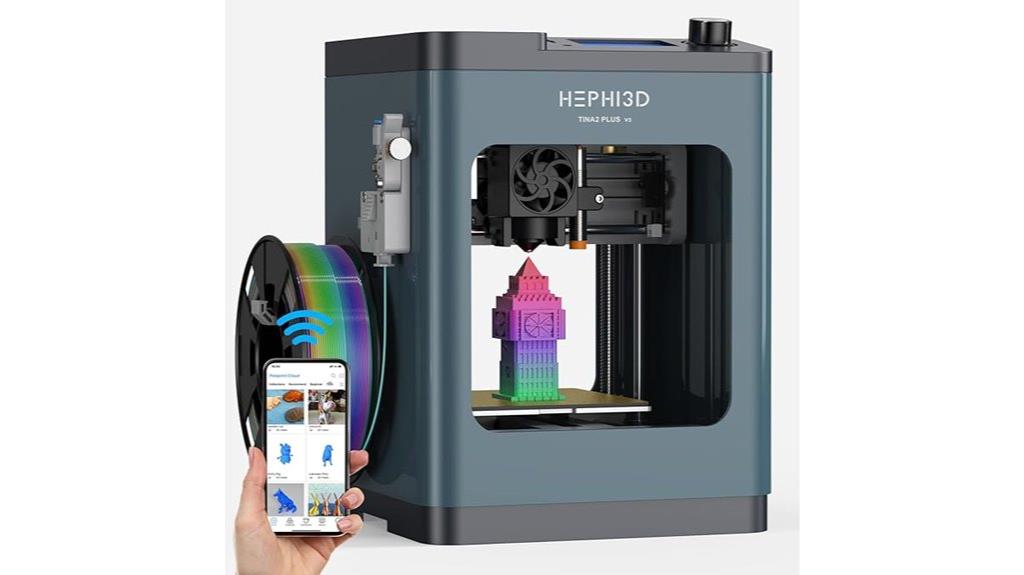
With its impressive 250mm/s maximum printing speed, the TINA2Plus 3D Printer stands out as an excellent choice for students and hobbyists who want fast, reliable results. Its recommended speed of 150mm/s cuts print times by 75%, saving you time and money. Fully assembled and easy to set up, it features auto bed leveling, making it perfect for beginners. The WiFi-enabled Poloprint Cloud app lets you print wirelessly, access a model library, and upload files from your phone or tablet. Compatibility with popular slicing software like Cura and PrusaSlicer offers customization options, supporting both simple projects and advanced modeling.
Best For: beginners, students, and hobbyists seeking fast, reliable, and easy-to-use 3D printing with wireless connectivity.
Pros:
- High-speed printing up to 250mm/s reduces overall print time significantly.
- Fully assembled with auto bed leveling makes setup quick and user-friendly.
- Wireless printing via WiFi and cloud app offers convenient file access and management.
Cons:
- Maximum speed may compromise some print detail if not properly calibrated.
- Limited to small-scale models due to compact size.
- Open-source software compatibility may require some technical knowledge for advanced features.
FLASHFORGE AD5M 3D Printer with Auto Calibration and Quick-Swap Nozzle

Thanks to its automatic calibration and quick-swap nozzle system, the FLASHFORGE AD5M is an excellent choice for both students and hobbyists who want reliable, high-quality prints without the hassle of manual adjustments. Its one-click leveling system ensures precise nozzle-to-build plate calibration, saving time and reducing errors. The flexible double-sided PEI steel plate makes removing prints easy and is optimized for PETG. The quick-release nozzles, available in multiple sizes, let you switch tools in just three seconds, supporting detailed and fast printing. With advanced remote monitoring and power outage recovery, the AD5M offers efficiency, durability, and user-friendly operation for all skill levels.
Best For: hobbyists, students, and professionals seeking reliable, high-quality 3D printing with minimal setup and maintenance.
Pros:
- Automated one-click calibration simplifies setup and ensures precise first layers
- Quick-swap nozzles support both detailed and rapid printing, saving time and effort
- Remote monitoring and power outage recovery enhance workflow efficiency and peace of mind
Cons:
- The all-metal motion system and advanced features may come at a higher price point compared to basic models
- The quick-release nozzles, while convenient, may require careful handling to avoid damage or improper fit
- As a high-speed printer, it may produce more noise and require a sturdy setup environment
FLASHFORGE Adventurer 5M 3D Printer with Auto Leveling System
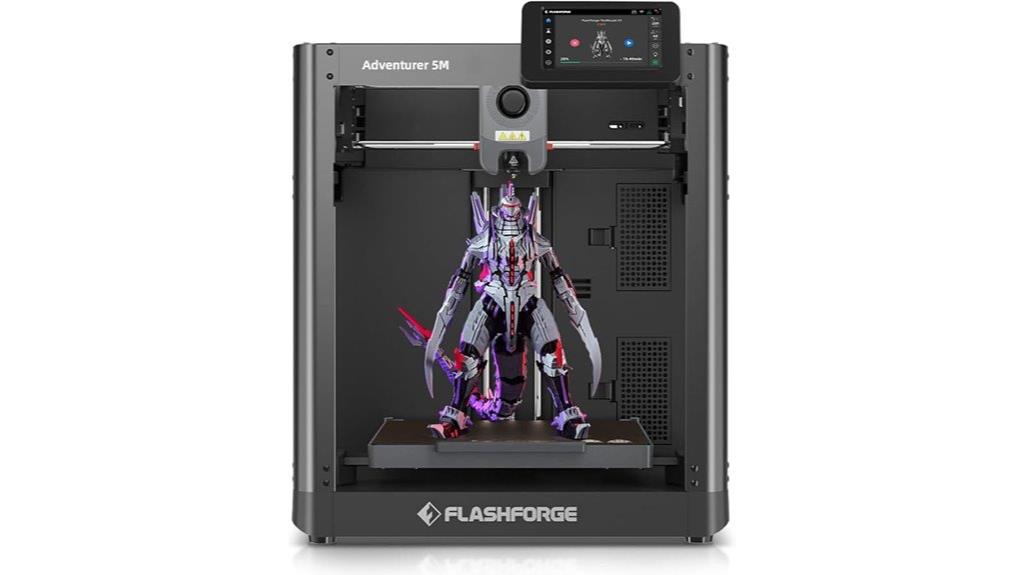
If you’re looking for a user-friendly 3D printer that combines speed, precision, and ease of use, the FLASHFORGE Adventurer 5M stands out as an excellent choice for students and hobbyists. It features a sturdy CoreXY metal structure supporting up to 600mm/s speeds, ensuring fast, high-quality prints. The fully automatic, one-click leveling system guarantees flawless first layers, saving time and frustration. With a quick-detachable nozzle in multiple sizes, flexible PEI steel build plate, and enclosed design, it minimizes noise, dust, and fumes. Priced around $300, this versatile printer offers reliable performance with easy setup and compatibility with various filaments.
Best For: hobbyists, students, and beginners seeking a reliable, easy-to-use 3D printer with fast setup and high-quality results.
Pros:
- Quick and straightforward setup with automatic leveling system
- Supports high-speed printing up to 600mm/s with stable operation
- Compatible with multiple filament types and includes a detachable nozzle for convenience
Cons:
- Software stability and remote connectivity can be inconsistent
- Limited remote control features and potential firmware bugs
- Small filament spool size (~53mm) may require frequent reloading
X-Maker 3D Printer for Kids and Beginners

The X-Maker 3D Printer is an excellent choice for kids and beginners because of its fully assembled, user-friendly design that makes setup and operation straightforward. Its intuitive software and 3.5-inch color touch screen provide easy navigation, while the enclosed design guarantees safety by containing fumes. The flexible magnetic build plate simplifies print removal, and the printer supports only one color at a time—perfect for simple projects. With wireless Wi-Fi connectivity, SD card, and USB options, it offers versatile operation. Quiet, accurate, and fast, it delivers high-quality prints using PLA filament, making it ideal for creative learning and home use.
Best For: beginners, kids, and parents seeking a safe, easy-to-use 3D printer for educational and creative projects at home or in classrooms.
Pros:
- Fully assembled and ready to use, ideal for beginners and children.
- User-friendly interface with a 3.5-inch color touch screen and intuitive software.
- Enclosed design enhances safety by isolating fumes and reducing noise during operation.
Cons:
- Supports only one color at a time, limiting multi-color printing options.
- Magnetic build plate may require replacement over time with frequent use.
- Suitable primarily for small-scale projects, not large or complex models.
Anycubic Kobra S1 3D Printer with Multi-Color Printing
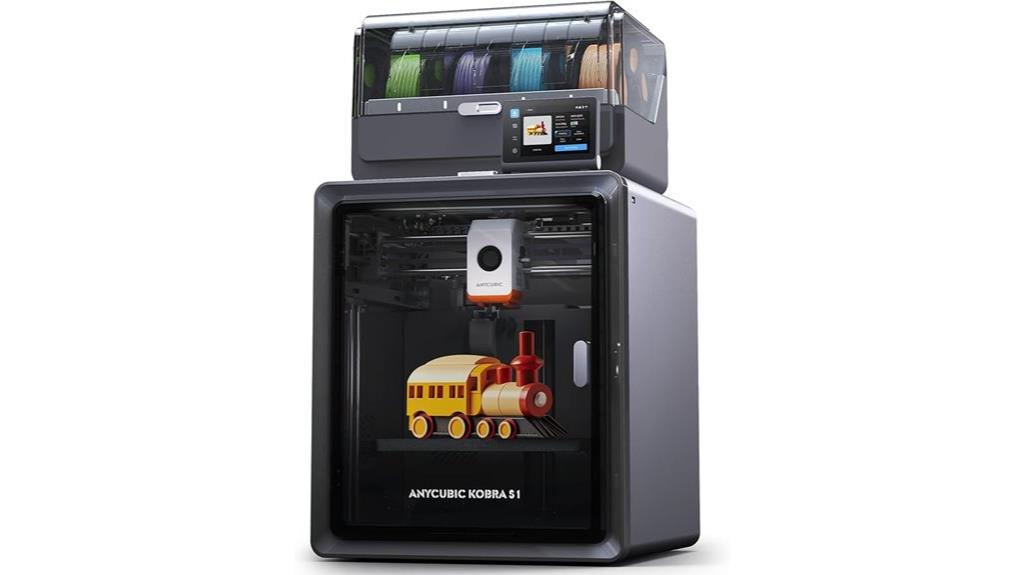
Designed for creativity and versatility, the Anycubic Kobra S1 3D Printer with Multi-Color Printing stands out for its ability to handle up to four colors simultaneously, making it perfect for students and hobbyists who want to bring complex, vibrant designs to life. Its compact size (9.8 inches on each side) packs high-speed, high-precision printing right out of the box, with features like sealed storage and intelligent filament drying to guarantee consistent quality. With speeds up to 600mm/s and advanced filament management, it produces detailed, smooth models efficiently. Plus, remote control via the Anycubic App adds convenience, making multi-color 3D printing accessible anytime.
Best For: hobbyists, students, and creative enthusiasts seeking high-speed, multi-color 3D printing with precision and versatility.
Pros:
- Supports up to four colors simultaneously, enabling vibrant and complex designs
- Exceptional printing speed of up to 600mm/s for rapid production
- Compact size with intelligent filament drying and remote operation via the Anycubic App
Cons:
- May require more advanced setup for multi-color printing compared to single-color units
- Limited build volume (9.8 inches per side) might restrict larger projects
- Higher initial cost due to multi-color capabilities and high-speed features
Geeetech 3D Printer for Kids & Beginners

For beginners and kids starting their 3D printing journey, the Geeetech M1s stands out with its user-friendly features and reliable performance. It prints quickly at up to 250mm/s, thanks to an advanced nozzle and a 50W heating rod for stable heat. The 16-point auto-leveling system and flexible magnetic build plate make setup and removal easy, reducing errors and warping. Fully assembled with a 2.4-inch color LCD screen, it’s simple to operate with knobs and one-button filament loading. Supporting both 500g and 1kg spools, this printer offers versatility for various projects, making it perfect for educational use and beginners alike.
Best For: Beginners, kids, and educators seeking an easy-to-use, reliable 3D printer for educational and creative projects.
Pros:
- User-friendly design with knobs and one-button filament loading simplifies operation for beginners.
- Fast printing speeds up to 250mm/s combined with auto-leveling and magnetic build plate ensure high-quality results with minimal setup.
- Fully assembled and supported by a comprehensive warranty, technical support, and filament holder options for versatility.
Cons:
- Limited print volume of approximately 3.94×4.33×3.94 inches may restrict larger projects.
- Support for only specific filament types like TPU and PLA; may require additional accessories for other materials.
- As a beginner-focused model, it may lack some advanced features found in professional-grade 3D printers.
Factors to Consider When Choosing 3D Printers for Students and Hobbyists
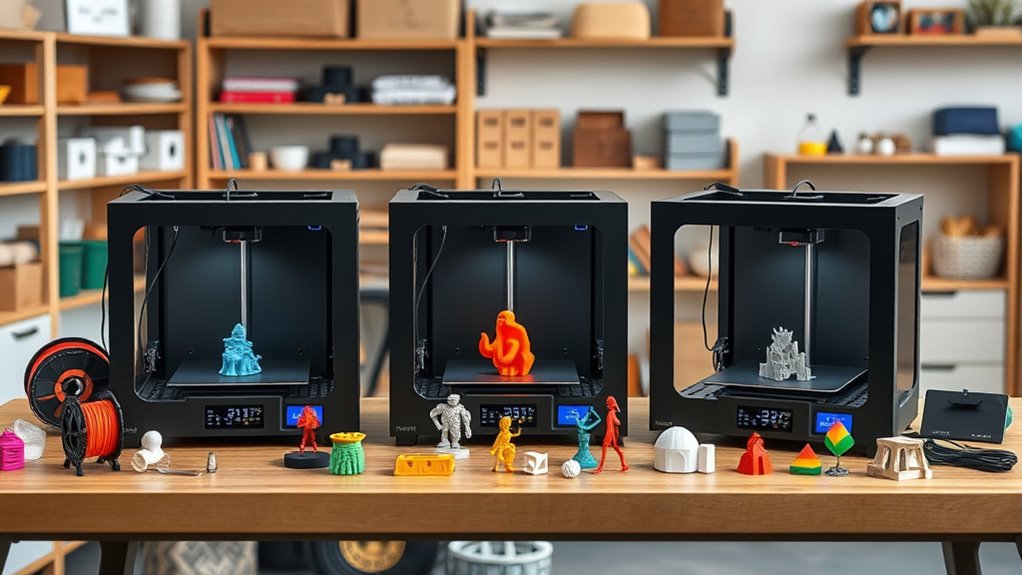
When selecting a 3D printer, I focus on factors like budget, ease of use, and build size to find the best fit. I also consider what materials the printer can handle and whether its software is user-friendly. These points help guarantee I choose a device that meets my needs without unnecessary complexity or expense.
Budget and Cost
Choosing the right 3D printer often comes down to budget, as prices for entry-level models generally range from under $200 to around $500. This price range affects available features and build quality, so a lower-cost printer may lack advanced functions like multi-color printing or auto-calibration. Investing a bit more can mean better durability, more reliable prints, and a longer lifespan, which saves money in the long run. Keep in mind that cheaper printers often require additional expenses for filament, maintenance parts, and upgrades, so consider these ongoing costs when making your decision. Comparing initial costs with operational expenses helps ensure you pick a model that offers the best value for your needs, balancing affordability with quality and performance.
Ease of Use
Ease of use plays a *vital* role in selecting a 3D printer, especially for students and hobbyists who may be new to 3D printing. An intuitive interface, like a color touchscreen or simple controls, makes it easier to learn and operate the printer quickly. Automated features such as bed leveling, filament loading, and calibration help minimize manual setup and troubleshooting, saving time and frustration. Fully assembled or straightforward assembly designs allow users to start printing without complex steps. Compatibility with beginner-friendly slicing software and pre-loaded models further streamlines the process, boosting confidence. Built-in safety features, like enclosed chambers and quiet operation, create a safer, more comfortable environment for newcomers. Overall, user-friendly features make 3D printing accessible and enjoyable for beginners.
Build Volume
The build volume of a 3D printer defines the largest object you can create in a single print, which is essential for matching the printer to your project needs. For students and hobbyists, common sizes range from about 100x100x100 mm for miniatures to larger areas up to 300x300x400 mm for bigger projects. A larger build volume lets you print bigger models, assemble multiple parts, or save time by printing several pieces simultaneously. However, bigger printers tend to be more expensive and may require more space. Smaller build volumes often mean faster prints, lower costs, and are ideal for beginners. When choosing, consider your typical project size, future ambitions, and available workspace to find the perfect balance.
Material Compatibility
When selecting a 3D printer, considering material compatibility is vital because it determines the range of projects you can undertake. I look for printers that support a variety of filament materials like PLA, ABS, TPU, PETG, and specialty filaments such as carbon fiber or composites, guaranteeing versatility. The maximum extruder temperature is fundamental—higher temps, around 300°C, allow for advanced filaments and heat-resistant parts. I also verify that filament compatibility aligns with the nozzle diameter and heated bed requirements, as some materials need specific setups for proper adhesion and quality. Additionally, I prefer printers with firmware and software that make switching between materials easy, facilitating multi-material or multi-color projects. Finally, an enclosure and cooling system suitable for warping-prone materials like ABS or nylon help guarantee successful, high-quality prints.
Software Compatibility
Choosing the right 3D printer isn’t just about hardware—it also depends heavily on software compatibility. I look for printers that support popular slicing programs like Cura, Simplify3D, or Repetier-Host, ensuring flexibility in preparing designs. Compatibility with open-source firmware such as Marlin or Klipper is a plus, as it allows for user customization and advanced control. I also check if the printer can connect via USB, SD card, or Wi-Fi, making it easier to manage files and monitor prints. Software updates and active community support are crucial for troubleshooting and gaining new features. Finally, I prefer user-friendly interfaces with features like auto-slicing, previewing, and real-time monitoring, which make the learning curve smoother and enhance the overall experience.
Frequently Asked Questions
What Safety Features Are Common in Beginner-Friendly 3D Printers?
Most beginner-friendly 3D printers come with safety features like enclosed build areas to prevent burns and contain fumes, automatic shut-off if overheating occurs, and filament detection sensors to avoid print failures. I always look for printers with these features because they help keep the environment safe and reduce accidents. These safety measures give me confidence to experiment and learn without constantly worrying about potential hazards.
How Do Print Resolution and Speed Impact Hobbyist Projects?
I know speed and resolution matter. Higher resolution makes my prints sharper and more detailed, perfect for intricate projects. Faster print speeds save me time, letting me experiment and iterate quickly. But I’ve learned balancing both is key—too fast, and quality drops; too detailed, and it takes ages. Finding the right mix helps me bring my creative ideas to life efficiently and with great detail.
Are There Specific Filament Types Best Suited for Students’ Use?
For students, I recommend PLA because it’s easy to print, eco-friendly, and affordable. It works well for prototypes and models. ABS is a good option if you need more durability, but it’s trickier to print and requires good ventilation. PETG is versatile, combining ease of use with strength. Ultimately, I’d choose based on your project needs, but PLA is often the best starting point for beginners.
What Maintenance Is Required to Keep 3D Printers Functioning Properly?
To keep my 3D printer working smoothly, I regularly clean the nozzle and build plate, check for loose belts and screws, and lubricate moving parts. I also update firmware and replace worn-out filament guides. Consistent maintenance prevents clogs and guarantees quality prints. I make a habit of inspecting everything after each project, so my printer stays reliable and ready to unleash my creativity whenever I need it.
How Does Software Compatibility Influence Printer Selection for Beginners?
Software compatibility really shapes my choice because it determines how smoothly I can design and print. If the printer works with user-friendly programs like Cura or Simplify3D, I get more control and fewer errors. Compatibility also affects updates and troubleshooting. So, I always check if my chosen 3D printer supports popular, easy-to-use software, ensuring my projects run seamlessly without technical hiccups.
Conclusion
Choosing the right 3D printer can truly spark your creativity. Did you know that the 3D printing industry is expected to grow at a CAGR of over 24% through 2025? That means more innovative tools and projects for hobbyists and students like us. So, pick the one that fits your needs, immerse yourself in building, and watch your ideas come to life. Your next great creation is just a print away!
